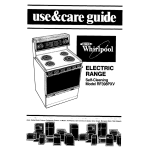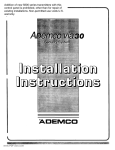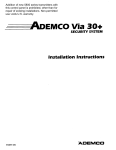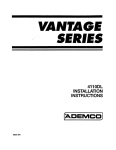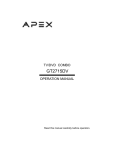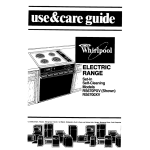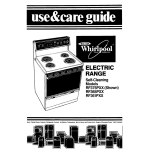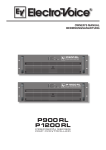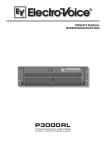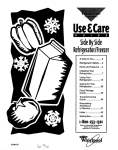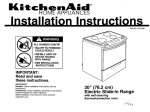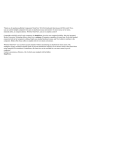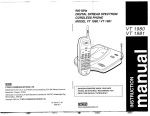Download FA100C Installation Manual
Transcript
Previous Menu FAI 1OC SECURITY This security k\\ N5672-1 V2 12/95 system 6 EOLR SYSTEM can support wired zones PROFESSlONAL SECURITY SYSTEMS CONGRATULATIONS! On Your Purchase The purpose of these Installation Instructions instructions for installing a basic system. of the FM 1OC is to give you a complete overview of the system, and provide CONTACTLNG TECHNICAL SUPPORT PLEASE, Before you call Technical Support, be sure your l l l l l l READ THE INSTRUCTIONS! Check all wiring connections. Determine that the power supply and/or backup battery are supplying proper voltages Verify your programming information where applicable. Note the proper model number of this product, and the version level (if known) along with any documentation that came with the product Note your customer number and/or company name. Having this information handy will make it easier for us to serve you quickly and effectively. You may contact Technical Support via Toll Free Fax. Please include your return Fax number. You will receive a reply within 24 hours. You may also contact Technical Support via modem to ATLIS-BBS, Tech Supports Electronic Bulletin Board System. Replies are posted within 24 hours. Premier Gold ‘Technical Support: l-800-538-5585 (8 a.m.-6 p.m. E.S.T.) After 6p.m. E.S.T.: l-800-421-5557 Please be sure you have your PIN number ready before calling. Technical ATLIS-BBS Support Fax Number: Electronic Bulletin l-800-447-5086 Board System: l-51 6-496-3980 (1200 - 9600 Baud, 8 Data Bits, 1 Start/Stop Bit, No Parity) I FOR YOUR CONVENIENCE, two easily removable Programming Forms have been included at the center of this manual. -2- I INFORMATION.. Section 1. GENERAL .......... Introduction ...................................................... ......................................... Zone Characteristics.. CONFIGURATIONS.. Section 2. SYSTEM ....... ZONE RESPONSE TYPE DEFINITIONS.. ................... HARD WIRED ZONES.. ........................................... Basic Control’s Zones ......................................... 3. MOUNTING THE CONTROL, ................. LOCK, & PC BOARD .......................................... Mounting the Cabinet Installing the Lock (if Used). ................................. Installing the Control’s Circuit Board.. ..................... .I3 Power Failure.. ................................................. .13 Other Displays (Fixed Word Keypads) .................. Section 6. PROGRAMMING THE SYSTEM .... ..l 4 .14 General Information ......................................... Summary of Programming Commands.. .................. 15 .15 Special Messages.. .......................................... .16 DATA FIELDS.. ............................ PROGRAMMING ........ .2 0 Section 7. SYSTEM COMMUNICATION .20 Report Code Formats ........................................ .5 5 5 . 6 7 7 Section 4. WIRING & POWERING THE SYSTEM ......................... Grounding the System.. ....................................... Terminals and Connections ................................. Power-up Procedure ......................................... 8 8 8 8 Section 8. REMOTE PROGRAMMING AND ..... (DOWNLOADING). CONTROL General information.. ........................................ Required.. ........................................ Equipment .2 1 .21 .21 .21 Programming.. ................................................. Remote Programming Advisory Notes.. ................. .22 .23 Section 9. TESTING THE SYSTEM ............. .23 Procedure.. ..................................................... Section 10. SPECIFICATIONS & .25 ACCESSORIES.. .................. .25 SPECIFICATIONS.. ............................................. .26 .............. ACCESSORIES (COMPATIBLE DEVICES). 28 ................................. FCC STATEMENTS Section OPERATION.. Section 5. SYSTEM ............. SECURITY CODES .............................................. Master Code.. .................................................. User Codes ...................................................... KEYPAD FUNCTIONS .......................................... General Information ........................................... Arming Functions .............................................. Keyswitch Operation (if installed) ........................ Panic Keys ...................................................... TROUBLE CONDITIONS ....................................... General Information .......................................... “Check’ and “Battery” Displays ........................... .9 9 .9 .I 0 .l 1 .l 1 .l 1 11 .I 1 11 12 ................... CANADIAN DOC STATEMENT LIMITATIONS OF THIS ALARM SYSTEM ............................. LIMITED WARRANTY .12 12 Diaarams .13 .13 .13 and ...... .2 9 .30 .3 1 Tables .24 GUIDE.. .................. TROUBLESHOOTING SUMMARY OF CONNECTIONS DIAGRAM.......2 7 .Centerfold FORM ................. PROGRAMMING -3- -4- Introduction Alarm Output Advisory System The FAl 1OC is a microprocessor-based security control. Zones Supported Supports up to 6 hard wired EOLR “basic” zones. Refer to the Zone Characteristics chart below for detailed zone information. Programming The system can be easily programmed from any of the remote consoles listed below. Programmed options to establish specific alarm and reporting features are stored in electrically erasable, nonvolatile EEROM memory. This means that the unit can be reprogrammed many times (unlike units equipped with PROMS) and that information which has been programmed will not be lost in the event of a complete loss of power. In addition, the system can be uploaded, downloaded, or controlled via a computer and Hayes modem (see REMOTE PROGRAMMING AND CONTROL on page 21). Remote Consoles The system may use one or more FA200KP, FA210KP, FA250KP, FA310KP, or Ademco 5330 Keypads. The first four have digital keypads and fixed English status LCDs. The 5330 provides programmable English language zone descriptors and status indications (select for Vector device, as described in the 5330’s installation instructions). Note: FA210KP, FA250KP, and FA310KP are addressable keypads and must be set to their non-addressable mode fdevice ID 31). The system may also be armed and disarmed using a keyswitch (Ademco No. 4116). User Codes Up to 3 secondary user codes can be assigned by the system’s Master code. Communication The system provides communication capability (central station reporting, etc.) over existing telephone lines. Zones Wired Programmable Zones. EOLR supervised, N.O. or N.C. sensors, 300-500 msec normal response. Optional fast (1 O-l 5msec) response programmable for zone 3. This system includes an alarm output rated at 2 amps. Throughout the manual, wherever reference is made to Alarm Output Ratings, they assume a fully charged battery is connected, unless the UL rating is stated. The battery is periodically tested automatically (approximately every four hours), and if it cannot sustain a load, a low battery message is displayed and can be reported to the central station. Multiple Consoles (up to 4...see page 9) may be used, as long as their total current drain is within the alarm and auxiliary power output limitations described in the SPECIFICATIONS AND ACCESSORIES section. Zone Characteristics 1-6 For more information, see page 7. Zones 7, 95, 96 For more information, see page 14. state-of-the-an Keypad Panics. 24hr zones. Zone 7 is programmable for silent, audible, auxiliary, or fire. Zones 95 (Silent Panic) and 96 (Audible Panic) are fixed-function zones. Duress (see User’s Manual). Tamper. Reports faults in the trouble-by-day/alarm-bynight zones and (when used) the arming/disarming keyswitch. For all report formats (except Contact ID, which provides more explicit reporting) a trouble code is reported when the system is not armed, and Zone 9 report code is sent for an alarm. -5- ZONE RESPONSE General Information TYPE DEFINITIONS Each zone must be assigned to a zone type, which defines the way in which the system responds to faults in that zone. Zone types are defined below. Zone l@e 2 is not used in this svstem. Program a zone with this zone type if the zone is not used. Zone Disabled (or Undefined) This zone type provides entry delay whenever the zone is faulted if the armed in the Away or Stay modes. When the panel is armed in the Maximum modes, no entry delay is provided. Exit delay begins whenever trol is armed, regardless of the arming mode selected. These delays grammable. This zone tyoe is usually assianed to sensors or contacts throuah which orimarv entrv and exit will take olace. piiiq Entry/ExitBurglary /Tiizq control is Instant or the conare proon doors This zone type gives an instant alarm if the zone is faulted when the panel is armed in the Away, Stay, Instant or Maximum modes. This zone tvoe is usually assianed to all sensors or contacts on windows and seldom used exterior doors. Perimeter Burglary Interior, piiiq Follower This zone type is active when the panel is armed in the Away or Maximum modes. Entry delay (using the programmed entry time) results if the panel is armed in the Away mode and the entry/exit zone is faulted first. Otherwise this zone type gives an instant alarm. Exit delay is present for any arming mode. This zone tvoe is usuallv assianed to a zone coverina an area such as a fover. lobbv. or hallway throuah which one must oass (upon entrv. after faultina the entrv/exit zone) to reach the kevoad to disarm the svstem. Since this zone type is designed to provide an instant alarm if the entry/exit zone is not violated first, it will protect an area in the event an intruder hides on the premises prior to the system being armed, or gains access to the premises through an unprotected area. This zone type is bypassed automatically when the panel is armed Stay or Instant. (Type This zone type will give an instant alarm if faulted when armed in the Away, Stay, Instant or Maximum (night) modes. During the disarmed state (day), the system will provide a latched trouble sounding from the keypad (and a central station report, if desired). This zone type is usuallv assianed to a zone which contains a foilprotected door or window (such as in a store). or to a zone coverina a “sensitive” area such as a stock room. drua SUDDIV room. etc. This type can also be used on a sensor or contact in an area where immediate notification of an entry is desired. Trouble Alarm by Day/ by Night ( 24-hour 24-hour Silent Alarm 1 Type 71 Audible Alarm m Auxiliary 24-hour Alarm [Type Supervised Fire lType[ Interior w/Delay This zone type sends a report to the Central Station but provides no keypad display or sounding. This zone tvoe is usuallv assianed to a zone containing an Emergency button. This zone type sends a report to the Central Station, and provides a rapid beeping sound at the keypad, and an audible external alarm. This zone tvoe is usually assianed to a zone that has an Emeraencv button. This zone type sends a report to Central Station and provides a rapid beeping sound at the keypad. (No bell output is provided). Usually assigned to a zone containing a button for use in personal emergencies, or to a zone Containing monitoring devices such as water or temperature sensors, etc. This zone type provides a fire alarm on short circuit and a trouble condition On open circuit. The bell output will pulse when this zone type is faulted. This zone type is always active and cannot be bypassed. This zone type can be assigned on/v to control oanel wired zone 5. or kevoad manic zone 7. This zone type gives entry delay (using the programmed entry time), if tripped when the panel is armed in the Away mode, regardless of whether or not an entry/exit delay zone was tripped first. This zone type is also active during Maximum mode, but no entry delay is provided (an alarm occurs immediately if the zone is tripped). Exit delay is present for any arming mode. This zone type is bypassed automatically when the panel is armed Stay or Instant. -6- HARD-WIRED Basic Control% ZONES Zones The FAl 1OC supports 6 hard-wired zones, which are connected as zones l-6 . These zones must be EOLH supervised, and can use N.O. and/or N.C. sensors. Zone Response Response Type Time Max. Zone Resistance EOLR Supervised Any zone response can be assigned to devices on these zones except Supervised Fire (09), which can be assigned only to zone 5 (see below). 300500 msec. Zone 3 is optionally programmable for fast (1 O-l 5msec) response. 300 ohms, excludina EOLR Supports both open circuit and closed circuit devices. Connect open circuit devices in parallel across the loop. The 1,000 ohm EOLR must be connected across the loop wires at the last device. Important If the EOLR is not at the end of the loop, the zone is not properly supervised. The system may not respond to an open circuit within the zone. Connect closed circuit devices in series with the loop. Of the 6 hard wired zones, only zone 5 can be used for fire. Supports as many 4-wire smoke detectors as can be powered. The zone must be configured for EOLR supervision. The detectors must be wired in parallel, with the EOLR at the last detector for full supervision. To supervise power, a supervisory module (e.g., System Sensor A77-7168 EOL Relay Module) is required. l l l EOLR Fire Zone 5 l l f l l l -7- 1 Mounting the Installing Installing Cabinet the Lock (if Used) the Control’s Circuit Board IMPORTANT! the installing Before contents, be cabinet’s sure to remove the appropriate metal cabinet knockouts. The FAl 1OC is supplied with a 12-l/2” (318mm) wide x 14-l 12” (368mm) high x 3” (76mm) deep cabinet suitable for use in most installations. Mount the control cabinet to a sturdy wall using fasteners or anchors (not supplied) in a clean, dry area which is not readily accessible to the general public. 4 mounting holes are provided at the back of the cabinet. Use an Ademco No. N6277 Cam Lock and No. N6277-1 Push-On Clip (Retainer Clip). 1. Remove the cabinet cover. If is easily removable for servicing and is easily reinstalled. 2. Remove the lock knockout from the control cabinet cover. Insert the key into the lock. Position the lock in the hole making certain that the latch will make contact with the latch bracket when the door is closed. 3. While holding the lock steady, insert the retainer clip into the retainer slots. Position clip as illustrated to facilitate easy removal. 1. Hang two long mounting clips (provided) on the raised cabinet tabs (see Detail B below). Insert the top of the circuit board into the slots at the top of the cabinet. Make sure that the board rests on the correct row (see Detail A ). Swing the base of the board into the mounting clips and secure the board to the cabinet with the accompanying screws (see Detail B). 2. 3. DO NOT ATTEMPT TO REMOVE THE KNOCKOUTS AFTER THE CIRCUIT BOARD HAS BEEN INSTALLED. -8- (See Summary IMPORTANT: Grounding the System Terminals and Connections of Connections Diagram on Page 27) Do not connect the battery, or plug in the AC transformer, until all other wiring connections have been completed. Terminal 21 is the earth ground connection point. In order for the protective devices in this product to be effective, the designated terminal must be terminated in a good earth ground. The following are examples of good earth grounds available at most installations: Metal cold water pipe: Use a non-corrosive metal strap firmly secured to the pipe to which the lead is electrically connected and secured. AC power outlet ground: Available from 3-prong, 120 VAC power outlets only. To test the integrity of the ground terminal, use a 3-wire circuit tester with neon lamp indicators, such as the UL Listed Ideal Model 61-035, or equivalent, available at most electrical supply stores. 1 & 2: AC Input (16SVAC, 25VA) from No. 13211TF2 plug-in transformer (in U.S.A.). Note: In Canadian installations, a No. 1321 CN transformer must be used. Alarm relay output(+), 12VDC, 2.OA maximum 3: (600mA max Alarm plus Aux Power for UL usage). 4: Ground (-) Return for Alarm Output Auxiliary Power and Wired Fire. Via their BLACK leads for Keypad(s)t and optional Keyswitch. +12VDC Output (at 500mA max.) for Auxiliary Power and Wired Fire. 5: Via their RED leads for Keypad(s)t and optional Keyswitch. Data In from Keypad(s)* and optional Keyswitch, via their GREEN leads. 6: Data Out to Keypad(s)t and optional Keyswitch, via their YELLOW leads. 7: Zone 1. Note: For each zone used, a 1,000 Ohm EOLR should be wired 8: between the farthest sensor connected to the zone terminal and the low side of the zone. Zones 1 and 2 Return. 9: 10: Zone 2 (see Note at zone 1) 11: Zone 3 (see Note at zone 1) 12: Zones 3 and 4 Return 13: Zone 4 (see Note at zone 1) 14: Zone 5 (see Note at zone 1) 15: Zones 5 and 6 Return. 16: Zone 6 (see Note at zone 1) Handset (TIP). 17: Handset (RING). 18: Incoming Phone Line (TIP). 19: Incoming Phone Line (RING). 20: EARTH GROUND (a proper earth ground must be provided to protect the 21: system from lightning and electrostatic discharge damage). Warning: To prevent the risk of electrical shock, disconnect the telephone line at the Telco jack before servicing the unit. Battery (+). When AC is present, 13.8VDC is being developed to RED LEAD: recharge a gel lead acid battery and when AC is absent, 12VDC current is drawn from the battery. Battery lead reversal will blow the battery fuse. BLACK LEAD: Battery (-). t Up to 4 Keypads may be used (check total auxiliary current, per SPECIFYCATIONS). Each 5330 Keypad used must be on an individual home run. No more than 220’ of #22 wire or 550’ of #18 wire should be used for each run. Addressable Keypads (e.g., FA310KP, FA250KP) may be used, if they are set to their non-addressable mode (device ID 31). -9- Power-up Procedure 1. 2. 3. 4. 5. Make sure that the total current to be drawn from the Alarm Output terminals (3 & 4) and Auxiliary Power Output terminals (4 & 5) does not exceed the values indicated in the SPECIFICATIONS section and on the SUMMARY OF CONNECTIONS diagram. Wire the transformer to the panel (before connecting the battery) as shown on the SUMMARY OF CONNECTIONS diagram. Do not plug in at this time. Connect all loops, devices, keypads, etc. to the panel. Plug the transformer into a 24 hour, uninterrupted AC outlet. After some initial displays (see page 15) and approximately one minute, the green POWER or READY LED on the keypad(s) should be lit and the keypads should indicate that the system is ready to arm. Connect the battery as shown in the SUMMARY OF CONNECTIONS diagram. -1 o- SECURITY CODES Master Code User Codes The installer programs the 4-digit Master Code initially as part of the programming procedure (see PROGRAMMING THE SYSTEM). The factory default Master code is “4110.” The Master code can permit re-entry into the programming mode and also, in normal operation mode, is used to enter the user codes, which also allow access to the normal functions of the system. See the PROGRAMMlNG section for information on exiting the programming mode via fields *98 or *99. In normal operation mode, the Master security code can be used to assign up to three secondary security codes. It can also be used to remove secondary codes from the system (individually). To assign (or change) a Secondary security code, enter: Master Code + [CODE key] + User # (2 or 3 or 4) + desired Secondary Code The system will emit a single beep when each secondary code has been successfully entered. To delete a Secondary security code, enter: Master Code + [CODE key] + User # (2 or 3 or 4) Notes: All Master and Secondary security codes permit access to the system for arming, disarming, etc. If a secondary code is inadvertently repeated for different users, or one user’s code is another’s duress code (4th digit increased by l), the lower user number will take priority. Opening and closing reports are sent for the Master code as No. 1. User codes are sent as Nos. 2, 3, and 4 respectively. l l l KEYPAD General FUNCTIONS Information Note that if QUICK ARM is enabled (field *21), the [#] key can be pressed instead of entering the security code, for any of the arming procedures (Away, Stay, Instant, Maximum, etc.). The security code is always required, however, when disarming the system. The keypad allows the user to arm and disarm the system, and perform other system functions, such as bypassing zones, and displaying zone descriptors. Zone and system conditions (alarm, trouble, bypass) are displayed in the Display Window. When an alarm occurs, keypad sounding and external sounding will occur, and the zone(s) in alarm will be displayed on the keypad. Pressing any key will silence the keypad sounder for 10 seconds. Disarming the system will silence both keypad and external sounders. When the system is disarmed, any zones that were in an alarm condition during the armed period will be displayed (memory of alarm). To clear this display, simply repeat the disarm sequence (enter the security code and press the OFF key). The keypads also feature chime annunciation, and 3 panic keys or key pairs. One is programmable for silent, audible, fire or personal emergency alarms. Two are fixed-function (one for silent and one for audible). The central station can be notified of an alarm condition, nected. -ll- if that service is con- Arming Functions The following is a brief list of system commands. For detailed information concerning system functions, refer to the User’s Manual. Disarmed, Not Ready Before arming, the system must be in the READY condition (all zones must be intact). If the “NOT READY” message appears, press the READY [*I key to display faulted zones. Arming Away Enter code + AWAY [2]. Arming Stay Enter code + STAY [3]. Arming instant Enter code + INSTANT [7]. Arming Maximum Enter code + MAXIMUM [4]. Disarming Enter code + OFF [l]. Bypassing Zones Enter code + BYPASS [6] + zone number(s). Forced (Quick) Bypass (If enabled) To automatically bypass all faulted zones, use “Quick Bypass” method: Enter code + BYPASS (then stop). Chime Mode Enter code + CHIME [9]. To turn chime mode off, enter code + CHIME again. Mode AWAY STAY INSTANT MAXIMUM Keyswitch Operation (if installed) Panic Keys IMPORTANT: For the Silent Panic function to be of practical value, the system must be connected to a central station. SUMMARY OF ARMING MODES Features for Each Arming Exit Entry Perimeter Delay Delay Armed Yes Yes Yes Yes Yes Yes Yes No Yes Yes No Yes Mode Interior Armed Yes No No Yes A single LED is used to indicate the status of the system: LED OFF = Not Ready for Arming SLOW FLASH = Ready for Arming Arming Away Turn key to right for 112 second. Arming Stay Hold key turned to right for more than one second. Keypads will beep twice (AWAY mode) or 3 times (STAY mode) and the keyswitch LED will flash rapidly. Turn key to right. Disarming If an alarm has occurred during the armed period, the keyswitch’s LED will not flash upon disarming (thus indicating memory of the alarm). Turning the keyswitch key to the right a second time after disarming can clear the alarm from memory, but it is advisable, instead, to refer to a keypad to diagnose and clear any problem, and to subsequently clear alarm memory. There are three panic key pairs and (on some keypads) lettered programmed, can be used to manually initiate alarms and send a central station. The key(s) for zone 7 can be programmed for 24 Hour Silent, Audible, Fire Emergency response. The key(s) for zones 95 and 96 have fixed-functions: 95 = Silent Panic, 96 = Audible Panic. The panic function is activated when both keys of the appropriate pressed at the same time, or the appropriate lettered key is pressed seconds. The panic functions are identified by the system as follows: l keys that, if report to the Personal or key pair are for at least 2 Keys [A], [B], [C] are not on all keypads. Key [D], if present, is not active here. Note: If [l] & [++I, or [A] is pressed after [3] & [#I, or [Cl, the initial display of zone 96 will be deleted from the keypad display, but the reports will go in properly (causing a silent alarm after an audible is not a likely scenario). -12- TROUBLE General CONDITIONS Information %heckl’ and EIBatteryU’ Displays The word “CHECK” on the Keypad‘s display, accompanied by a rapid “beeping” at the Keypad, indicates that there is a trouble condition in the system. The audible warning sound can be silenced by pressing any key. Instruct users to call for service immediately upon seeing any of the following messages. l l Power Failure l l l (Fixed Other Displays Word Keypads) A display of “CHECK” and one or more zone numbers indicates a problem exists with the displayed zone(s) and requires attention. When the problem has been corrected, the display can be cleared the OFF sequence (code plus OFF key) twice. A display of “BAT” with no zone number indicates that main standby battery is weak. If there is no keypad display at all, and the POWER present) is not lit, operating power for the system has stopped tem is inoperative. If the message POWER indicator power only. “AC LOSS” or “NO AC” is displayed, (if present) is off, the system is operating that by entering the system’s indicator (if and the sysand the on battery If the battery standby capacity is used up during a prolonged power outage, the control’s auxiliary power will shut down to minimize discharge of the battery. AC deep dl This may appear occasionally for a few seconds during normal system operation, but if this remains displayed for more than 1 minute, the system is disabled. CC The system is in communication tion or status verification. FC 0 C A communication failure has occurred. The keypad is not receiving signals from the control panel and sees an open circuit. -13- with the central station for change of func- General Information Installer options are stored in non-removable, electrically erasable, non-volatile EEROM memory. These options must be programmed for the particular installation to establish its specific alarm and reporting features. Note: It is possible to program the system at any time, even at the installer’s premises prior to the actual installation. Simply apply power temporarily to the control and then program the unit as desired. THE sEcuRin coNTRoLMAY BE PROGRAMMED AN FA200KP (FIXED ENGLISH) KEYPAD OR A 5330 (ALPHA) KEYPAD. (or a Download...see page 21) An FA21OKP, FA250KP or FA310KP (Addressable, FIXED ENGLISH) Keypad may be used, provided it is set to its non-addressable mode (device ID 311. VIA Note: The initial sequence of entries should follow the order on the programming sheet. When programming, the field number will be displayed on the keypad’s display; also, each entry is displayed as it is keyed in. After programming, values that have been entered in each field can be reviewed and, if necessary, modified. When programming from the keypad, note the following: 1. Enter the Programming mode by simultaneously depressing the [*] and [#] keys within 50 seconds after power is applied to the Control, or subsequently by keying the code 4 + 1 + 1 + 0 followed by depression of CODE + 0 keys. If a different Master code is subsequently programmed, use it instead of 4110 to gain access to the Programming mode. If the frogramming mode was exited previously using a X98, it will prevent entry into the Programming mode by the use of the Master Code + CODE + 0. 2. Immediately following entry into the program mode, field l 20 will be displayed. (If a 5330 keypad is used, 00 will be displayed. Enter ++20 to access the programming start point.) Following the above display, the system is ready to accept entries for field l 20. 3. To program a data field, key [+I+] plus Field No. (for example, *21), then make the required entry. 4. To simply review a data field, key [#] plus Field No. No changes will be accepted in this mode. 5. When a data field has been completely programmed, the keypad will normally “beep” three times and then automatically display, the next data field number to be programmed (if not, key [++I plus the Field No. of the next field to be programmed). 6. If the number of digits that you enter in the data field is less than the maximum permitted (for example, phone number), then the keypad will display the last data entered. To proceed, the next data field number to be programmed must then be entered (for example, l 42). 7. If a field is improperly entered, the keypad will display EE. Simply re-enter [*I or [#] plus the field number. -14- Summary of Programming Commands PROCEDURE FUNCTION ENTER PROGRAMMING EXIT PROGRAMMING MODE MODE ADVANCE TO FIELD PROGRAM FIELD ERASE FIELDS l-.F.A r,r, n nt/MJ Special Messages I-IIILU 1. POWER UP, then depress [+] and [#] both at once, within 50sec of powering up. OR 2. Initially, key: 4 + 1 + 1 + 0 plus CODE key + 0. OR 3. If different Master Code is programmed, key : MASTER CODE + CODE KEY + 0 (if %98 was used to exit previously, method 1 above must be used to enter the program mode again) +#9 9 allows re-entry to programming mode via type 2 or 3 entry method above. +#9 8 inhibits re-entry to programming mode via type 2 or 3 entry method. [*] + Field No. (e.g., 21, 38, 55, etc.) [a] + Field No., followed by data entries. [*] + Field No. + [U] (only applies fields 40 thru 43 and 94). w,n. C%-.-. I.1 lirj + rleia NO. to OC = OPEN CIRCUIT (no communication between Keypad and Control). EE = ERROR (program entry mistake). Re-enter the field number or data). After powering up, AC, dl (disabled) and NOT READY will be displayed after approximately 4 seconds. This will revert to READY in appx. 1 minute, which allows PIRS, etc. to stabilize. To bypass this delay, press: [#] + [O]. -15- PROGRAMMING [THE CENTERFOLD DATA FIELDS PROGRAMMING SYSTEM ARMING (*20-•28) *20 l 21 *22 *23 *28 ZONE RESPONSE PROGRAMMING (*29-*39) l 29 *30 FORM CAN BE USED TO RECORD THE DATA FOR THIS INSTALLATION 1 MASTER CODE Enter 4 digits, O-9 (entry of all 4 is mandatory). Use of a “9” in the last position inhibits the Ambush feature. QUICK ARM ENABLE If enabled, [#] key can be used instead of security code when arming the system. The security code is always required when disarming. Enter 0 for disabled or 1 for enabled. KEYSWITCH ENABLE Enter 0 for no or 1 for yes. FORCED BYPASS FUNCTION All zones that are bypassed by this function will be displayed after the bypass is initiated. 0 = No forced bypass. 1 = Allows forced bypass of all open zones. CONFIRMATION OF ARMING DING Enter 0 for no or 1 for yes. If selected, ding is external sounder only and will occur at time of kissoff of closing report. If closing report is not programmed, ding will occur at end of exit time. FIRE SOUNDER TIMEOUT 0 = Fire sounder times out at end of bell timeout period (field l 30). 1 = Fire sounder continues until silenced manually. ALARM BELL TIMEOUT External sounder will shut off after time allotted. Enter 1 digit. 0 = No timeout 2 = 8 minutes 1 = 4 minutes 3 = 12 minutes ZONE TYPES FOR PROGRAMMING FIELDS *31-•37 0 = Zone Disabled (or Undefined) 6 = 24 Hr (Silent) 7 = 24 Hr (Audible) 1 = ENTRY/EXIT, Burglary 8 = 24 Hr (Auxiliary) 2 = not used 9 = FIRE (Fields l 35 and l 37 only) 3 = PERIMETER, Burglary 10 = INTERIOR w/DELAY, Burglary 4 = INTERIOR/FOLLOWER, (To program, enter # + 10) Burglary 5 = TROUBLE BY DAY/ ALARM BY NIGHT, Burglary *31 ‘32 ‘33 *34 *35 ‘36 l 37 l 38 ZONE 1 RESPONSE TYPE Enter 1 digit from Zone Type Table above. ZONE 2 RESPONSE TYPE Enter 1 digit from Zone Type Table above. ZONE 3 RESPONSE TYPE Enter 1 digit from Zone Type Table above. ZONE 4 RESPONSE TYPE Enter 1 digit from Zone Type Table above. ZONE 5 RESPONSE TYPE Enter 1 digit from Zone Type Table above. ZONE 6 RESPONSE TYPE Enter 1 digit from Zone Type Table above. ZONE 7 RESPONSE TYPE (Keypad Panic, Key B or *&#) Enter 1 digit from Zone Type Table above. Only zone types 0, 6, 7, 8, 9 are applicable ENTRY DELAY System will wait the time allotted before sounding alarm upon entering. (EXIT delay = Entry delay plus 15 seconds) 4 = 60 seconds 0 = 0 seconds 2 = 30 seconds 5 = 90 seconds 1 = 20 seconds 3 = 45 seconds -16- l 39 DIALER PROGRAMMING (‘40-•49) *40 *41 l 42 *43 l 44 ZONE 3 RESPONSE TIME TO OPEN 0 = 400ms nominal 1 = 10ms nominal PABX ACCESS CODE Enter 4 digits, O-9, for each PABX digit needed to access an outside line. To skip this field, enter *. If X is entered, no PABX number will be dialed and nothing will appear in this field. End field by entering +~41 if not filled. To clear entries from field, press +%40%. PRIMARY PHONE No. Enter up to 12 digits, O-9. Do not fill unused spaces. End field by entering *42 if not filled. To clear entries from field, press *4l*. Note: Back-up reporting (8 calls are made to the secondary phone number if no kiss-off is received after 8 attempts to the primary number) is automatic only if there is a secondary phone number. SECONDARY PHONE No. See field l 41 entry info. and Note. End field by entering *43 if not filled. To clear entries from field, press X42t. SUBSCRIBER ACCOUNT. No. Enter digits O-9; #+l l=B; #+12&Z; #+13=D; #+14=E; or #+15=F. Enter +Kas the fourth digit if a 3 digit acct no. (for 3+1 dialer reporting format) is used. Enter 0 as the first digit of a 4-digit acct no. for nos. OOO& 0999. End field by pressing +# (and press next field) if only 3 digits are used. To clear entries from field, press ++43+K. REPORT FORMAT Determine which format is to be used to report to the central station. Enter 1 digit. 0 = 3+1; 4+1 ADEMCO Low Speed Standard 1 = 3+1; 4+1 Radionics Standard 2 = 4+2 ADEMCO Low Speed Standard 3 = 4+2 Radionics Standard 6 = 4+2 ADEMCO Express 7 = ADEMCO Contact ID Reporting 8 = 3+1; 4+1 ADEMCO Low Speed Expanded 9 = 3+1; 4+1 Radionics Expanded (Enter +Kas the 4th digit of *43, if 3+1 dialer reporting is to be used.) 1 For explanation l 45 l 46 *47 l 48 of these fcyfnzfts, see page 20. 1 PHONE SYSTEM SELECT Enter 1 digit. If Central Station Rcvr is noton WATS line: 0 = Pulse Dial 1 = Tone Dial If Central Station Rcvr is on WATS line: 2 = Pulse Dial 3 = Tone Dial SESCOA/RADIONICS SELECT 0 = Radionics (O-9, B-F reporting) 1 = SESCOA (O-9 only reporting) Select 0 for all other formats. 15 SECOND DIALER DELAY (BURGLARY) Allows time for subscriber to avoid a false alarm transmission. Enter 0 for no or 1 for yes PERIODIC TEST MESSAGE 0 = no test report 1 = 24 hr. test 2 = weekly test If yes is selected, the Test Report Code entered in field *64 will be Sent approximately 12 hours after local programming or uploading/downloading the program, and every 24 hours or every week thereafter. The report timing will not be offset appreciably by connection to the downloader unless uploading or downloading is done. Checking status, arming, etc. will affect the timing on/y to the extent of the connection time to the communicator. -17- *49 ALARM REPORT CODES (*50-39) *50 SPLIT/DUAL REPORTING Enter 0 to disable (Backup report only) or enter digit selected from the following table: To Primarv Phone No. To Secondarv Phone No. l= Alarms, Restore, Cancel Other Reports 2 = All reports except Open/Close, Test Open/Close, Test 3= Alarms, Restore, Cancel All Reports 4 = All reports except Open/Close, Test All Reports 5= All Reports (Dual Reporting) All Reports 1ST DIGIT OF ZONES 95 AND 96 ALARM REPORT CODES Zone 95= Keypad Panic, Key A or l&X (Silent) Zone 96= Keypad Panic, Key C or 3&# (Audible) Enter the first digit of Zone 95’s alarm report code in the left-hand box and 96’s in the right-hand box. Select 1-9, 0, B, C, D, E, or F. Enter “#+lO” for 0, “#+ll” for B, “#+12” for C, “#+13” for D, “#+14” for E, “#+15” for F. The second digit of each alarm report code (for 4 + 2 or expanded format) will be the same as that for zone 7 (as programmed in field l 57). For any format, if a “0” (not “#+lO”) is programmed for the first digit, no report is generated. TO PROGRAM REPORT CODES FOR ALARM, SYSTEM STATUS, AND RESTORE (*51-‘74) With a 3+1 or 4+1 Standard Format: Enter a code in the first box: 1-9, 0, B, C, D, E, or F. Enter “#+lO” for 0, ‘I#+11 ’ for B, “#+12” for C, “#+13” for D, “#+14” for E, “#+15” for F. A “0” (not “#+lO”) in the first box will disable a report. A “0” (not “#+lO”) in the second box will result in automatic advance to the next field when programming. With an Expanded or 4+2 Format: Enter codes in both boxes (1st and 2nd digits) for 1-9, 0, or B-F, as described above. A “0” (not “#+lO”) in the second box will eliminate the expanded message for that report. A “0” (n’ot “#+lO”) in both boxes will disable the report. With Ademco Contact ID Reporting: Enter any digit (other than “0”) in the first box, to enable zone to report This is an “enabling” code only and is disregarded in the actual reporting to the central office. Entries in the second boxes will be ignored. A “0” (not “#+lO”) in the first box will disable the report. See examples on programming form. ZONE 1 ALARM REPORT CODE l 51 See box above. ZONE 2 ALARM REPORT CODE ‘52 See box above. ZONE 3 ALARM R.EPORT CODE l 53 See box above. ZONE 4 ALARM REPORT CODE l 54 See box above. ZONE 5 ALARM REPORT CODE l 55 See box above. ZONE 6 ALARM REPORT CODE l 56 See box above. ZONE 7 ALARM REPORT CODE *57 (Keypad Panic, Key B or * 81 #) See box above, and field *50. ZONE 8 ALARM REPORT CODE ‘58 (Duress) See box above. ZONE 9 ALARM REPORT CODE “59 (Tamper) See box above. -18- SYSTEM STATUS REPORT CODES l 60 (*60-*68) *61 l 62 l 63 ‘64 l 65 *66 *68 RESTORE REPORT CODES (*69-*74) ‘69 l 70 *71 l 72 *73 l 74 l 93 DOWNLOAD INFORMATION (‘94, l 95) *94 TROUBLE REPORT CODE See box above *51. BYPASS REPORT CODE See box above l 51 . AC LOSS REPORT CODE See box above *51. LOW BAT REPORT CODE See box above *51. TEST REPORT CODE See box above *51. OPEN REPORT CODE See box above *51. 2nd digit = User #, if expanded or 4+2 reporting is selected. CLOSE REPORT CODE See box above*Sl. 2nd digit = User #, if expanded or 4+2 reporting is selected. Report also sent for Arming STAY, if contact ID format is used. CANCEL REPORT CODE See box above l 51 . GROUP RESTORES FOR TROUBLE, BYPASS Enter 0 for no (report for each restore) or 1 for yes (report after all zones restored). Note: “1” not applicable to Contact ID reporting. ALARM RESTORE REPORT CODE, 1ST DIGIT 2nd digit is automatically sent as the 2nd digit of the zone alarm report code programmed in fields *50-*59, if expanded or 4+2 reporting is selected. TROUBLE RESTORE REPORT CODE See box above l 51 . BYPASS RESTORE REPORT CODE See box above l 51 . AC RESTORE REPORT CODE See box above ‘51. CODE LOW BATTERY RESTORE REPORT See box above *51. REPORTS PER ARMED PERIOD 0 = 10 max. alarm + alarm restore messages 1 = unlimited DOWNLOAD PHONE NUMBER Enter up to 12 digits; O-9. Do not fill unused spaces. End field by entering +++.To clear entries from field, press *94X. ‘95 RING DETECTION COUNT FOR DOWNLOADING Enter number of rings before control picks up phone line (or 0 or 15). 0 = disable station initiated download l-14 = # of rings 15 = answering machine defeat INITIALIZE DOWNLOAD ID AND SUBSCRIBER ACCT. No. l 96 FOR DOWNLOADING (No data entry required, loads defaults) ZEROES ALL PROGRAM FIELDS *97 (No data entry required) IPress +K98 or X99 if exiting programming, or next Field No. if continuing. ] TO EXIT PROGRAMMING MODE (*98 or *99) l 98 l 99 EXITS PROGRAMMING MODE and prevents re-entry by : Master Code + CODE + 0 EXITS PROGRAMMING MODE and allows re-entry by: Master Code + CODE + 0 or by: Power-up + * + #. -19- Report Code Formats The Report Codes for Alarm, System Status, and Restore shown in fields *SO-*74 in the previous section can be designated in field l 44 to report to the central station in any of the following formats: a 3 (or 4) digit subscriber The 3+1 and 4+1 Standard formats comprise number Close). and a single digit report code (e.g. Alarm, Trouble, Restore, Open, The 3+1 and 4+1 Expanded formats comprise a 3 (or 4) digit subscriber number, and a single digit report code, followed by a second line where the report code is repeated 3 (or 4) times and followed by another number (normally the zone number) or user ID related to that report. The 4+2 formats comprise either a 4 digit subscriber number and two digit report code, or a 4 digit subscriber number and single digit report code, immediately followed by the zone number (normally) or user ID. The Ademco Contact ID Reporting format (see next page) comprises a 4 digit subscriber number, 1 digit event qualifier (“new” or “restore”), 3 digit event code, 2 digit “OO”, and 3 digit zone, contact ID, user, or system status number Report Alarm 3+1, 4+1 Standard SSS(S) A Trouble SSS(S) T Bypass SSS(S) B AC Loss SSS(S) E Low Batt SSS(S) L Open SSS(S) 0 Close SSS(S) c Test SSS(S) G Alarm Restore SSS(S) R AC Restore SSS(S) RA 3+1, 4+1 Expanded SSS(S) A ANA) Z SSS(S) T J-m-It SSS(S) B BBB(B) b SSS(S) E EEE(E) AC SSS(S) L LLL(L) LB SSS(S) 0 000(O) u SSS(S) c Ccc(C) u SSS(S) G GWG)g SSS(S) R RRR(R) Z SSS(S) RA LoBat Res. SSS(S) RL RARARA(RA)A, SSS(S) RL SSSS RLLB Trouble Res. sss(s) flT RLRLRL(RLYB SSS(S) RT ssss t+t Bypass Res. St%(s) RB RTRTRT (RT)t SSS(S) RB ssss RBb &$BRB Where: SSS or SSSS = A= Z= Tt = Bb = EAC = LLB = 0 = Subscriber ID Alarm Code-l st digit Typically Zone Number*-2nd digit Trouble Code (1st & 2nd digits) Bypass Code (1 st & 2nd digits) AC Loss Code (1st & 2nd digits) Low Battery Code(lst & 2nd digits) Open Code-l st Digit *Zone number for: [m] & [#] or [B] = 7 Duress = 8 Tamper = 9 -2o- C= IJ = Gg = R= RTt = RBb = RAAC = RL L B = 4+2 ssss AZ SSSS Tt SSSS Bb SSSS EAc ssss i-LB ssss ou ssss cu SSSS Gg ssss RZ SSSSRA A, (k$J Close Code-l st Digit User Number (1 st & 2nd digits) Test Code (1st & 2nd digits) Restore Code (Alarm)1 st & 2nd dlglts Restore Code (Trb1)ls.t & 2nd digits Restore Code (Byps)lst & 2nd digits Restore Code (AC)1 st & 2nd digits Restore Code (Bat)1 st & 2nd digits [l] & [*I or [A] = 95 [3] & [#I or [C] = 96 Ademco Contact ID Reporting takes the following format: CCCCQEEEGGZZZ where: CCCC = Customer (subscriber) ID Q= Event qualifier, where: E = new event, and R = restore EEE = Event code (3 hexadecimal digits) Note: For a complete list of event codes, refer to the central off ice receiver manual. GG= Always 00. ZZZ= Zone/contact ID number reporting the alarm, or user number for open/close reports. System status messages (AC Loss, Walk Test, etc.) contain zeroes in the ZZZ location. General Information Equipment Required Programming The control can be remotely programmed from an IBM compatible Personal Computer (PC), a Hayes Modem, and First Alert’s FADL Software (as specified below). Programming the control from a remote location is protected against compromise by someone attempting to defeat the system, using multi-levels of security protection: 1 . Security Code Handshake: An 8-digit download ID code must be matched between the control and the downloader . 2. Site Initiated Remote Programming: The installer or subscriber initiates the callback from the subscriber premises (by pressing MASTER CODE + # + 1) while disarmed. All parameters can then be downloaded via the phone lines using a personal computer. 3. Station Initiated Remote Programming: The operator calls the site from your office to initiate the download call. The control hangs up and then calls back the PC via the preprogrammed telephone number. The unit can then be uploaded, downloaded, or controlled from your office . 4. Data Encryption: Data passed between the PC and the control is encrypted for security so that it is very difficult for a foreign device tapped into the phone line to take over communication and substitute system compromising information. At the premises: l FAl 1OC and keypad. At the installer’s office: l An IBM PC compatible computer. l Either a Hayes brand Smartmodem 1200 [Level 1.2 or higher external or Level 1 .l or higher (with 4 position DIP switch) internal style], ora Hayes brand Optima 24 Plus FAX96 Modem. l An FADL Downloading Software Diskette (Rev. 3.0, or higher). l Appropriate interconnecting cables. The downloading system can perform many functions when in communication with the control unit. Besides uploading and downloading, the status of the systern can be observed and various commands can be initiated, as follows: l Arm the System in the Away Mode; Disarm the System. l Bypass a Zone. l Force the System to Accept a New Program Download. l Shut Down Communication (dialer) Functions (non-payment of monitoring fees in an owned system). . Shut Down all Security System Functions (non-payment for a leased system). . Inhibit Local Keypad Programming (prevents account takeover). . Command the System to Upload a Copy of its Resident Program to the Office. . Read: Arming Status, AC Power Status, Lists of Faulted Zones, Bypassed Zones, Zones Currently in Alarm, and Zones Currently in Trouble. -21- Remote Programming Advisory Notes Notes: After the control and the PC have established valid communication, each keypad on the system will become inactive and will display “CC” or “MODEM COMM.” The control, however, will still be scanning its zones and looking for alarms. If an alarm does occur, after communication is broken off, alarms are sounded and the proper dialer reports are sent to the central station. The consoles will become active after the download communication is terminated. The detailed operation of the download functions is covered in the installation instructions for the FADL Downloading Software Diskette. 0 Alarm and trouble reporting will be delayed during the time that the system and the Downloader are linked to each other following a valid exchange of codes, but the proper message will get through to the Central Station after the link is broken. Keypad entries are ignored during the time interval stated above. A copy of the program downloaded may be produced from the IBM PC compatible computer, using the product’s internal report generator, when an optional printer is connected (consult your PC manual for proper printer and connections). Program Upload or Download Time: 45 seconds. The Firmware Revision Level now reported to the downloader is .03 or higher. -22- Procedure After installation 1. 2. is completed, the Security System should be carefully tested. With ttie System in the disarmed state, check that all zones are intact. If NOT READY is displayed, press the [*(cl key to display the faulted zone(s). Restore faulted zone(s) if necessary, so that READY is displayed. Fault and restore every sensor individually to assure that it is being monitored by the system. Enter the security code and press the TEST key. The outside sounder (if used) will sound for 1 second and then turn off each time a zone is faulted. A test report should be transmitted (if programmed) to the Central Station immediately. If the backup battery is discharged or missing, the sounder may not turn on and a LOW BATTERY report will be transmitted instead of a TEST report. The keypad will beep once per minute as a reminder that the system is in the Test Mode. To turn off the test mode enter the security code and press the OFF key. Alarm messages will be sent to the central station lowing tests 3 and 4. Notify them in advance that progress. during the foltests will be in 3. Arm the system and fault one or more zones. After 15 seconds (if optional dialer delay is selected), silence alarm sounder(s) by entering the code and pressing OFF. Check Entry/Exit delay zones. 4. Check the keypad-initiated alarms that are in the system by pressing the Panic key(s) for: Zone 7: [+%8. #] or [B], or Zone 96: [3 & #] or [C] Zone 95: [l & +c] or [A], for audible emergency (zone 96, or, if so-programmed, zone 7), the keypad will emit a steady alarm sound, and ALARM and zone number will be d$p;yed. Silence the alarm by entering the security code and pressing . For silent emergency (zone 95, or, if so-programmed, zone 7), there will be no audible alarms or displays, but a report will be sent to the central station. Reset the zone by entering the security code and pressing OFF. Notify the central station when all tests are finished, and verify results with them. 5 -23- TROUBLESHOOTING GUIDE SYSTEM POSSIBLE 2. -Periodic keypad. beep(s) from CAUSE REMEDY 1. System battery is low or missing. 1. Check battery. 2. System is in TEST mode. 2. Enter ‘Code’ + OFF to exit TEST mode. 3 Sensors not properly installed, wired, or monitored. Protected door or window opened while system armed. Improper user operation of exit/entry delays. 3. Check installation to see if in accordance with established procedure. 4a. Check with all occupants of protected home. Check setting of entry delay . Exit delay is 15 seconds longer than the entry delay time. Remind user of same. Check all openings for proper switch and magnet orientation. 4a. 4b. 4c. 4d. Magnets located too far from switches, and/or doors and windows not properly aligned. Magnetic contacts improperly connected or wire broken. 4e. Entry door programmed 4f. Loose fitting door or window being raffled by wind or vibrations. I as ‘instant.’ 4b. 4c. 4d. 4e. 4f. Check wiring connections. Be sure wires are properly stripped and tightly fastened to screw teninals. Check and revise program. Reprogram transmitter number. Mount magnet closer to contact. J CONTROL SYMPTOM POSSIBLE 1. “AC POWER” light “NO AC” displayed. 2. Digital communicator message not being received. off or Interrupted 2a. 2b. 2c. 3. System in TEST mode. Telephone connection not secure. Telephone number in program needs prefix or access code. Telephone call to central monitoring statior requires operator assistance. Digital communicator malfunctioning. Ready light not on. 4a. “CC” or “MODEM COMM” displayed. 4b. “dl” displayed. 4b. 2e. Does 4. Control doesn’t keystrokes on not arm properly. respond keypad. to AC power supply. SMOKE SYMPTOM 1. 2. Detector parent Detector’s alarms, reason. siren sounds. I la. 1. Check transformer connection line circuit breaker. 2a. 2b. 2c. 2e. Remove from TEST mode. Check all connections. Program prefix or access code into FAllOC. FAl 1OC system cannot work in this situation. Check with a different FAllOC.. 3. Try Bypass arming. 4a. System is in communication with downloader at central station. Wait until download session is finished. System has just been powered and is in its one minute initialization. To bypass this time, press ‘#’ + ‘0’. 2d. and power I DETECTOR POSSIBLE I no ap- REMEDY 1. 2d. 3. 1 CAUSE CAUSE Dust, dirt in sensing chamber. 1 b. Improper location. lc. 2a. Unit malfunctioning. Unit not receiving required power. 2b. Unit malfunctioning. -24- I I la. REMEDY Clean units sensina chamber with vacuum cleaner per unit’s ir%tructions. 1b. See units instructions for locations to avoid. Relocate as necessary. 1c. Replace detector. 2a. Check for proper installation of battery. Try new battery. 2b. Replace detector. SECURITY FAliOC CONTROL 1 . Physical: 12-l/2” W x 14-l/2” H x 3” D (318mm x 368mm x 76mm) 2. Electrical: VOLTAGE INPUT: 16SVAC from plug-in 25VA transformer, No. 1321/TF2 (in U.S.A.). Note: For Canadian installations, a No. 1321 CN transformer must be used. RECHARGEABLE BACK-UP BATTERY:1 2VDC, 4Ah (Gel type), Ademco No. 467 Charging Voltage: 13.8VDC. ALARM SOUNDER: 12V, 2.0Amp output can drive 12V BELLS or can drive one or two 702 (series connected) self-contained 20-watt sirens. Do not connect two 702s in parallel. AUXILIARY POWER OUTPUT: 12VDC, 500mA max. interrupts for smoke detector reset. Note: For UL installations, Alarm Sounder plus Auxiliary Power currents should not exceed 6OOmA total. STANDBY TIME: 5 HRS with Auxiliary load of 500mA (using 4AH battery).To determine total standby battery load, add 100mA to total Aux. power output and remote keypad currents. FUSE: Battery (3A) No. 90-12 3. Communication: FORMATS SUPPORTED: Ademco Express, 10 characters/set, DTMF (TouchTone) Data Tones, 1400/2300Hz ACK, 1400Hz KISSOFF. Ademco Contact ID Reporting, 10 characters/set., DTMF (TouchTone) Data Tones, 1400/2300Hz ACK, 1400Hz KISSOFF. Ademco Low Speed, 10 pulses/set, 1900Hz Data Tone, 1400Hz ACWKISSOFF. Radionics/SESCOA, 20 pulses/sec,l800HzData Tone, 2300Hz ACWKISSOFF. Line Seize: Double Pole Can report O-9, B-F FCC Registration No.: AC 398U-68192-AL-E Ringer Equivalence: 0.78 REMOTE FA200KP KEYPAD 1 . Physical: 55/8” W x 4-1 l/16” H x 7/8” D (143mm x 119mm x 22mm) Current Drain: 20mA 2. Electrical: Voltage Input: 12VDC, 3. Interface Wiring: GREEN: Data Out to Control RED: 12VDC input (+) aux pwr BLACK: Ground YELLOW: Data In from Control REMOTE FA210KP KEYPAD 1 . Physical: 5-3/4” W x 4-3/4” H x 1” D (146mm x 131mm x 25mm) Current Drain: 30mA 2. Electrical: Voltage Input: 12VDC, 3. Interface Wiring: Same as FA200KP above. REMOTE FA250KP KEYPAD 1 . Physical: 5-l/16” W x 6-3/8” H x l-3/4” D (129mm x 162mm x 45mm) Current Drain: 120mA 2. Electrical: Voltage Input: 12VDC, 3. Interface Wiring: Same as FA200KP above. -25- REMOTE FA31 OKP KEYPAD 1 . Physical: 2. Electrical: 3. Interface RED: BLUE: GREEN: YELLOW: BLACK: REMOTE 5330 ALPHA KEYPAD 8.4” W x 4.75” H x 1.1” D (213mm x 121 mm x 28mm) Voltage Input: 12VDC, Current Drain: 60mA Wiring: 12VDC input (+) aux pwr 18VDC input from optional No. 1350 or 1360 Power Pack (not usable on UL installations) Data Out to Control Data In from Control Ground and (-) connection from optional No. 1350 or 1360 Power Pack 1 . Physical: 7-3/4” W x 4-7/16” H x l-1/4” D (197mm x 113mm x 32mm) 2. Electrical: Voltage Input: 12VDC, Current Drain: 105mA 3. Interface Wiring: Same as FA200KP on preceding page. (Select Vector Device) ACCESSORIES Accessories (COMPATIBLE No. No. No. No. 132l/TF2 132lCN 702 740 No. 4116 System PA400B 1412 2412 2412TH A77-716B DEVICES) 16.5VAC, 25VA Plug-In Transformer (in U.S.A.) 16.5VAC, 25VA Plug-in Transformer (in Canada) Self-contained 20 watt Siren (indoor or outdoor). Extremely loud Piezoelectric Alarm Sounder, 122dB output (indoor or outdoor). Tampered Single LED Remote Station (Arming/Disarming Keyswitch). Note: Obtain Lockswitch separately (Ademco No. 2174-70, 4073-70, or 4005-70). Sensor: Piezoelectric Alarm Sounder, 90dB output (mounts in single-gang box). 4-wire Ionization Products of Combustion Detector 4-wire Photoelectric Smoke Detector 4-wire Photoelectric Smoke Detector w/l 35°F (57°C) Heat Detector EOL Relay Module (Supervisory Module for wired fire zone) TO THE INSTALLER Regular maintenance and inspection (at least annually) by the installer and frequent testing by the user are vital to continuous satisfactory operation of any alarm system. The installer should assume the responsibility of developing and offering a regular maintenance program to the user as well as acquainting the user with the proper operation and limitations of the alarm system and its component parts. Recommendations must be included for a specific program of frequent testing (at least weekly) to insure the system’s proper operation at all times. -26- I I I I -- IH ~ -\ 4 r+t \ \I NMU~H L.. -27- t-j aNnot avdAm :wvm UL NOTICE: FEDERAL This COMMUNICATIONS is a “Grade A” residential COMMISSION (FCC) Part system. 15 STATEMENT This equipment has been tested to FCC requirements and has been found acceptable for use. The FCC requires the following statement for your information: This equipment generates and uses radio frequency energy and if not installed and used properly, that is, in strict accordance with the manufacturer’s instructions, may cause interference to radio and television reception. lt has been type tested and found to comply with the limits for a Class B computing device in accordance with the specifications in Pan 15 of FCC Rules, which are designed to provide reasonable protection against such interference in a residential installation. However, there is no guarantee that interference will not occur in a particular installation. If this equipment does cause interference to radio or television reception, which can be determined by turning the equipment off and on, the user is encouraged to try to correct the interference by one or more of the following measures: l If using an indoor antenna, have a quality outdoor antenna installed. l Reorient the receiving antenna until interference is reduced or eliminated. l Move the radio or television receiver away from the receiver/control. l Move the antenna leads away from any wire runs to the receiver/control. l Plug the receiver/control into a different outlet so that it and the radio or television receiver are on different branch circuits. If necessary, the user should consult the dealer or an experienced radio/television technician for additional suggestions. The user or installer may find the following booklet prepared by the Federal Communications Commission helpful: “Interference Handbook” This booklet is available from the U.S. Government Printing Office, Washington, DC 20402. The user shall not make any changes or modifications to the equipment unless authorized by the installation Instructions or User’s Manual. Unauthorized changes or modifications could void the user’s authority to operate the equipment. FEDERAL COMMUNICATIONS COMMISSION (FCC) Part 68 STATEMENT This equipment complies with Part 68 of the FCC rules. On the front cover of this equipment is a label that contains, among other information, the FCC registration number and ringer equivalence number (REN) for this equipment. If requested, this information must be provided to the telephone company. An RJ31 X is used to connect this equipment to the telephone network. This equipment uses the following jacks: The REN is used to determine the quantity of devices which may be connected to the telephone line. Excessive RENs on the telephone line may result in the devices not ringing in response to an incoming call. In most, but not all areas, the sum of the RENs should not exceed five (5.0). To be certain of the number of devices that may be connected to the line, as determined by the total RENs, contact the telephone company to determine the maximum REN for the calling area. If this equipment causes harm to the telephone network, the telephone company will notify you in advance that temporary discontinuance of service may be required. If advance notice is not practical, the telephone company will notify the customer as soon as possible. Also, you will be advised of your right to file a complaint with the FCC if you believe necessary. The telephone company may make changes in its facilities, equipment, operations, or procedures that could affect the operation of the equipment. If this happens, the telephone company will provide advance notice in order for you to make the necessary modifications in order to maintain uninterrupted service. If trouble is experienced with this equipment, please contact the manufacturer for repair and warranty information. If the trouble is causing harm to the telephone network, the telephone-company may request you remove the equipment from the network until the problem is resolved. There are no user serviceable components in this product, and all necessary repairs must be made by the manufacturer. Other repair methods may invalidate the FCC registration on this product. This equipment cannot be used on telephone company-provided coin service. Connection to Party Line Service is subject to state tariffs. This equipment is hearing-aid compatible. When programming or making test calls to an emergency number, briefly explain to the dispatcher the reason for the call. Perform such activities in the off-peak hours; such as early morning or late evening. , -28- CANADIAN DEPARTMENT OF COMMUNICATIONS (DOC) STATEMENT NOTICE ‘The Canadian Department of Communications label identifies certified equipment. This certification means that the equipment meets certain telecommunications network protective, operational and safety requirements. The Department does not guarantee the equipment will operate to the user’s satisfaction. Before installing this equipment, users should ensure that it is’ permissible to be connected to the facilities, of the local telecommunications company. The equipment must also be installed using an acceptable method of connection. In some cases, the company’s inside wiring associated with a single line individual service may be extended by means of certified connector assembly (telephone extension cord). The customer should be aware that compliance with the above conditions may not prevent degradation of service in some situations. Repairs to certified equipment should be made by an authorized Canadian maintenance facility designated by the supplier. Any repairs or alterations made by the user to this equipment, or equipment malfunctions, may give the telecommunications company cause to request the user to disconnect the equipment. Users should ensure for their own protection that the electrical ground connections of the power utility, telephone lines and internal metallic water pipe system, if present, are connected together. This precaution may be particularly important in rural areas. Caution: User should not attempt to make such connections themselves, but should contact the appropriate electric inspection authority, or electrician, as appropriate. The Load Number (LN) assigned to each terminal device denotes the percentage of the total load to be connected to a telephone loop which is used by the device, to prevent overloading. The termination on a loop may consist of any combination of devices subject only to the requirement that the total of the Load Numbers of all the devices does not exceed 100. AVIS L’etiquette du ministere des Communications du Canada identifie le materiel homologue., Cette etiquette certifie que le materiel est conforme a certaines normes de protection, d’exploitation et de securite des reseaux de telecommunications. Le ministere n’assure toutefois pas que le materiel fonctionnera a la satisfaction de I’utilisateur. Avant d’installer ce materiel, I’utilisateur doit s’assurer qu’il est permis de le raccorder aux installations de I’entreprise locale de telecommunications. Le materiel doit egalement Qtre install6 en suivant une methode acceptee de raccordement. Dans certains cas, les fils interieurs de I’entreprise utilises pour un service individuel a la ligne unique peuvent etre prolong& au moyen d’un dispositif homologue de raccordement (cordon prolongateur telephonique interne). L’abonne ne doit pas oublier qu’il est possible que la conformite aux conditions &on&es ci-dessus n’empeche pas la degradation du service dans certaines situations. Actuellement, les entreprises de telecommunications ne permettent pas que I’on raccorde leur materiel aux prises d’abonnes, sauf dans les cas precis prevus par les tarifs particuliers de ces entreprises. Les reparations du materiel homologue doivent Qtre effect&es pas un centre d’entretien canadien autorise designe par le fournisseur. La compagnie de telecommunications peut demander a I’utilisateur de debrancher un appareil a la suite de reparations ou de modifications effect&es par I’utilisateur ou a cause de mauvais fonctionnement. Pour sa propre protection, I’utilisateur doit s’assurer que tous les fils de mise en terre de la source d’energie electrique, des est lignes telephoniques de reseau de conduites d’eau, s’il y en a, soient raccordes ensemble. Cette precaution particulierement importante dans les regions rurales. Avertissement: L’utilisateur ne doit pas tenter de faire ces raccordements lui-meme; il doit avoir recours a un service d’inspection des installations electriques, ou a un electricien, selon le cas. C’indice (IC) assigne a chaque dispositif terminal pour eviter toute surcharge indique le pourcentage de la charge totale qui peut Qtre raccorde a un circuit telephonique boucle utilise par ce dispositif. La terminaison du circuit boucle peut Qtre constituee de n’importe quelle combinaison de dispositifs, pourvu que la somme des indices de charge de I’ensemble des dispositifs ne depasse pas 100. -29- THE LIMITATIONS WARNING OF THIS ALARM SYSTEM While this System is an advanced design security system, it does not offer guaranteed protection against burglary, fire or other emergency. Any alarm system, whether commercial or residential, is subject to compromise or failure to warn for a variety of reasons. For example: l Intrusion detectors (e.g., passive infrared detectors), smoke detectors, and many other sensing devices will not work without power. Battery-operated devices will not work without batteries, with dead batteries, or if the batteries are not put in properly. Devices powered solely by AC will not work if their AC power supply is cut off for any reason, however briefly. l A user may not be able to reach a panic or emergency button quickly enough. l While smoke detectors have played a key role in reducing residential fire deaths in the United States, they may not activate or provide early warning for a variety of reasons in as many as 35% of all fires, according to data published by the Federal Emergency Management Agency. Some of the reasons smoke detectors used in conjunction with this System may not work are as follows. Smoke detectors may have been improperly installed and positioned. Smoke detectors may not sense fires that start where smoke cannot reach the detectors, such as in chimneys, in walls, or roofs, or on the other side of closed doors. Smoke detectors also may not sense a fire on another level of a residence or building. A second floor detector, for example, may not sense a first floor or basement fire. Finally, smoke detectors have sensing limitations. No smoke detector can sense every kind of fire every time. In general, detectors may not always warn about fires caused by carelessness and safety hazards like smoking in bed, violent explosions, escaping gas, improper storage of flammable materials, overloaded electrical circuits, children playing with matches, or arson. Depending on the nature of the fire and/or location of the smoke detectors, the detector, even if it operates as anticipated, may not provide sufficient warning to allow all occupants to escape in time to prevent injury or death. l Passive Infrared Motion Detectors can only detect intrusion within the designed ranges as diagrammed in their installation manual. Passive Infrared Detectors do not provide volumetric area protection. They do create multiple beams of protection, and intrusion can only be detected in unobstructed areas covered by those beams. They cannot detect motion or intrusion that takes place behind walls, ceilings, floors, closed doors, glass partitions, glass doors, or windows. Mechanical tampering, masking, painting or spraying of any material on the mirrors, windows or any part of the optical system can reduce their detection ability. Passive Infrared Detectors sense changes in temperature; however, as the ambient temperature of the protected area approaches the temperature range of 90” to 105°F (32” to 40°C) the detection performance can decrease. l Alarm warning devices such as sirens, bells or horns may not alert people or wake up sleepers if they are located on the other side of closed or partly open doors. If warning devices are located on a different level of the residence from the bedrooms, then they are less likely to waken or alert people inside the bedrooms. Even persons who are awake may not hear the warning if the alarm is muffled by noise from a stereo, radio, air conditioner or other appliance, or by passing traffic. Finally, alarm warning devices, however loud, may not warn hearing-impaired people. l Telephone lines needed to transmit alarm signals from a premises to a central monitoring station may be out of service or temporarily out of service. Telephone lines are also subject to compromise by sophisticated intruders. l Even if the system responds to the emergency as intended, however, occupants may have insufficient time to protect themselves from the emergency situation. In the case of a monitored alarm system, authorities may not respond appropriately. l This equipment, like other electrical devices, is subject to component failure. Even though this equipment is designed to last as iong as 20 years, the electronic components could fail at any time. The most common cause of an alarm system not functioning when an intrusion or fire occurs is inadequate maintenance. This alarm system should be tested weekly to make sure all sensors and transmitters are working properly. The security control (and remote keypad) should be tested as well. Installing an alarm system may make the owner eligible for a lower insurance rate, but an alarm system is not a substitute for insurance. Homeowners, property owners and renters should continue to act prudently in protecting themselves and continue to insure their lives and property. We continue to develop new and improved protection devices. Users of alarm systems owe it to themselves and their loved ones to learn about these developments. -3o- 3 YEAR , LIMITED WARRANTY Pittway Corporation, and its divisions, subsidiaries and affiliates (“Seller”), 165 Eileen Way, Syosset, New York 11791, warrants its First Alert products to be in conformance with its own plans and specifications and to be free from defects in materials and workmanship under normal use and service for 36 months from the date stamp control on the product or, for products not having a date stamp, for 30 months from date of original purchase unless the installation instructions or catalog sets forth a shorter period, in which case the shorter period shall apply. Seller’s obligation shall be limited to repairing or replacing, at its option, free of charge for materials or labor, any product which is proved not in compliance with Seller’s specifications or proves defective in materials or workmanship under normal use and service. Seller shall have no obligation under this Limited Warranty or otherwise if the product is altered or improperly repaired or serviced by anyone other than First Alert factory service. For warranty service, return product transportation prepaid, to First Alert Factory Service, 165 Eileen Way, Syosset, New York 11791. THERE ARE NO WARRANTIES, EXPRESS OR IMPLIED, OF MERCHANTABILITY, OR FITNESS FOR A PARTICULAR PURPOSE OR OTHERWISE, WHICH EXTEND BEYOND THE DESCRIPTION ON THE FACE HEREOF. IN NO CASE SHALL SELLER BE LIABLE TO ANYONE FOR ANY CONSEQUENTIAL OR INCIDENTAL DAMAGES FOR BREACH OF THIS OR ANY OTHER WARRANTY, EXPRESS OR IMPLIED, OR UPON ANY OTHER BASIS OF LIABILITY WHATSOEVER, EVEN IF THE LOSS OR DAMAGE IS CAUSED BY THE SELLER’S OWN NEGLIGENCE OR FAULT. Seller does not represent that the products it sells may not be compromised or circumvented; that the products will prevent any personal injury or property loss by burglary, robbery, fire or otherwise; or that the products will in all cases provide adequate warning or protection. Customer understands that a properly installed and maintained alarm may only reduce the risk of a burglary, robbery, fire or other events occurring without providing an alarm, but it is not insurance or a guarantee that such will not occur or that there will be no personal injury or property loss as a result. CONSEQUENTLY, SELLER SHALL HAVE NO LIABILITY FOR ANY PERSONAL INJURY, PROPERTY DAMAGE OR OTHER LOSS BASED ON A CLAIM THE PRODUCT FAILED TO GIVE WARNING. HOWEVER, IF SELLER IS HELD LIABLE, WHETHER DIRECTLY OR INDIRECTLY, FOR ANY LOSS OR DAMAGE ARISING UNDER THIS LIMITED WARRANTY OR CTHERWISE, REGARDLESS OF CAUSE OR ORIGIN, SELLER’S MAXIMUM LIABILITY SHALL NOT IN ANY CASE EXCEED THE PURCHASE PRICE OF THE PRODUCT, WHICH SHALL BE THE COMPLETE AND EXCLUSIVE REMEDY AGAINST SELLER. This warranty replaces any previous warranties and is the only warranty made by Seller on this product. No increase or alteration, written or verbal, of the obligations of this Limited Warranty is authorized. -31- A DIVISION OF PIllWAY CORP. 172 Michael Drive Syosset, New York 11791 N5672-lV2 1245 Copyright 0 1995 PIllWAY CORPORATION
































